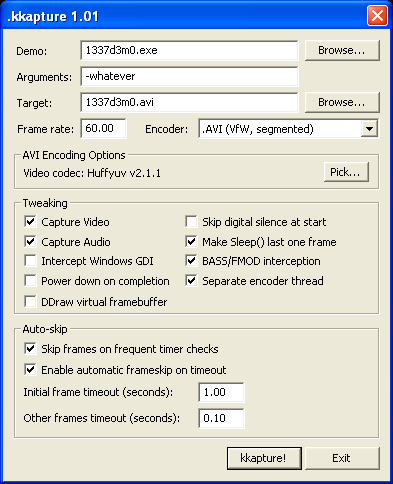Choose the demo you want to capture. kkapture should work with most demos using DirectDraw surfaces, Direct3D8/9/10 or OpenGL, fullscreen and windowed. Read the compatibility list file "working_demos.txt" that comes with kkapture for useful hints.
If a demo doesn't work (black screen at start or at the end or nothing captured):
- Take a look at the "kkapturelog.txt" log file that has been created in the folder you ran the demo from. If there are messages about directshow errors try choosing a different compression codec (AVI Enconding options->Pick) and/or a different encoder (Encoder->".AVI, VfW segmented" should usually work, but has a 2GB segment limit. You'll need to combine the files afterwards.)
- You can also try changing the "Tweaking" options. It often helps to use the "New startup interception".
- If you can't capture a demo in fullscreen mode, try windowed mode (if available) and vice-versa.
- If you have a demo that doesn't correctly shut down at the end while kkapturing it the video will most likely be broken. Try pressing CTRL-BREAK at the end. kkapture should terminate then and close the avi file properly. If that doesn't work, but the demo offers a loop mode you can work around the problem by using this and pressing ESC at the right moment...
- When capturing some demos (e.g. Heaven7) with kkapture the demo closes the window, but still executes and kkapture terminates the hooking thread (so CTRL-BREAK is NOT working). The video won't be correctly written, 'cause kkapture can't properly close the file. You'll need to kill the demo process with the task manager...
If this happens with a file that has multiple parts (using the VFW-encoder), you won't be able to concat the files, because of the missing AVI/RIFF header in the last file. The good thing is that you can fire up your favorite hex-editor (HxD is quite good) and copy the AVI/RIFF header (Offset 0, Lenght 2048 Bytes), from a working file you captured, to the non-working one. When you open it with Virtualdub then (set the error mode to "conceal"), it'll complain about missing indices, but you should be able to process the video.
- Demos of the 1999-2001 era often use GDI and DirectDraw in a strange combination. Try checking the "Intercept Windows GDI" box for those.
- Some demos created in that time also rely on the drawing area having a pitch of the bufferWidth * nrOfBytesPerPixel. This is not always true, as there can be a stride (empty area) at the end of each buffer line. If your image comes out somehow shifted or totally screwed up, try checking the "DDraw virtual framebuffer" option.
Take a look at the conversion page for tips on compressing the resulting videos to a final, suitable format.
If you want you can contact me:  |



